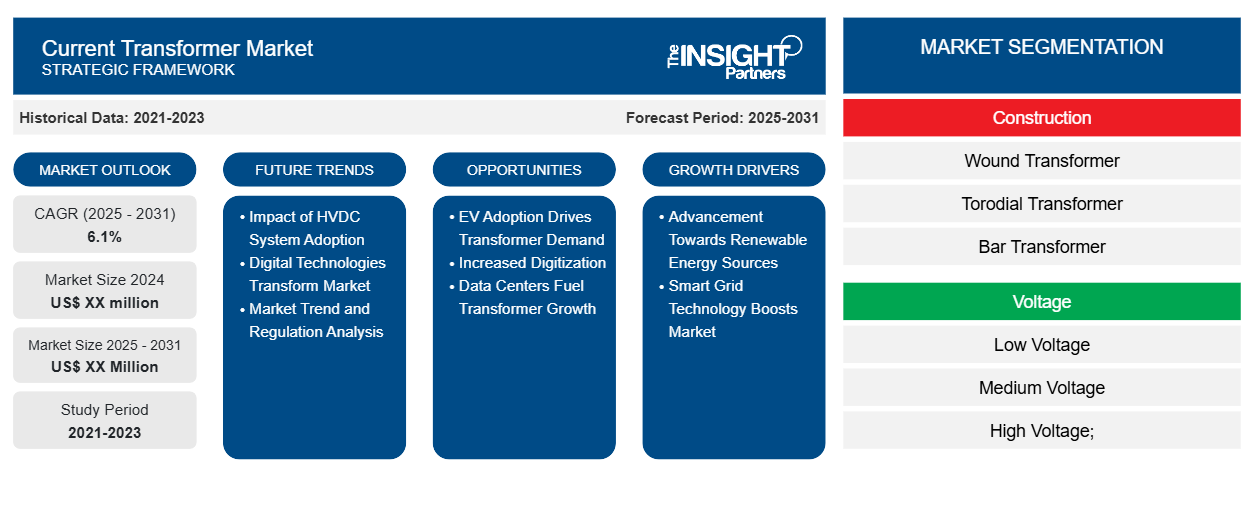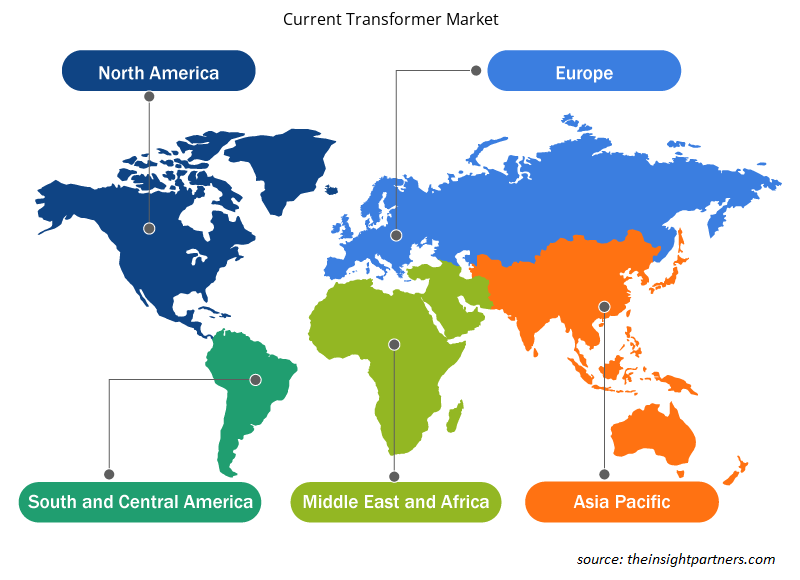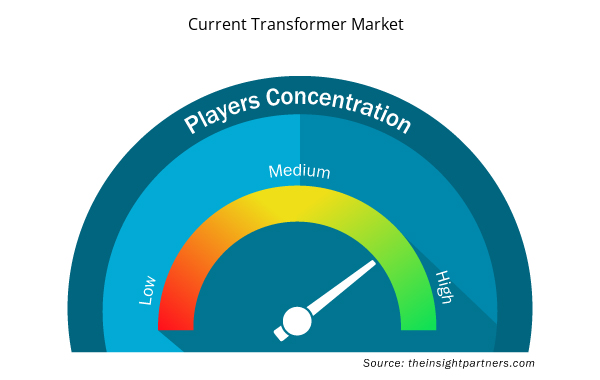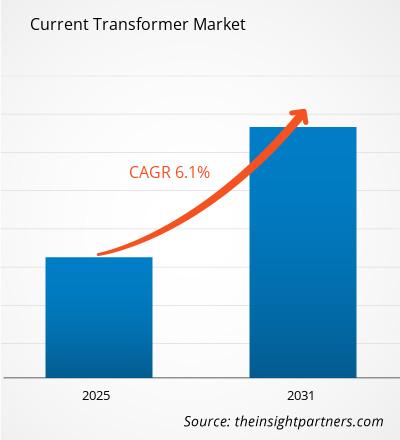Se espera que el mercado de transformadores de corriente registre una CAGR del 6,1 % entre 2025 y 2031, con un tamaño de mercado que se expandirá de US$ XX millones en 2024 a US$ XX millones en 2031.
El informe del mercado de transformadores de corriente abarca el análisis por construcción, voltaje, uso y aplicación. Geográficamente, el mercado está segmentado en Norteamérica, Europa, Asia Pacífico, Sudamérica y Centroamérica.
Propósito del Informe
El informe "Mercado de Transformadores de Corriente" de The Insight Partners busca describir el panorama actual y el crecimiento futuro, los principales factores impulsores, los desafíos y las oportunidades. Esto proporcionará información a diversas partes interesadas del negocio, como:
- Proveedores/Fabricantes de Tecnología: Para comprender la dinámica cambiante del mercado y conocer las oportunidades potenciales de crecimiento, lo que les permitirá tomar decisiones estratégicas informadas.
- Inversores: Realizar un análisis exhaustivo de tendencias respecto a la tasa de crecimiento del mercado, las proyecciones financieras del mercado y las oportunidades que existen en toda la cadena de valor.
- Organismos reguladores: Regular las políticas y las actividades policiales en el mercado con el objetivo de minimizar el abuso, preservar la confianza de los inversores y defender la integridad y estabilidad del mercado.
Segmentación del mercado de transformadores de corriente
Construcción
- Transformador bobinado
- Transformador toroidal
- Transformador de barra
Voltaje
- Bajo voltaje
- Media tensión
- Alto voltaje;
Solicitud
- Sector energético
- Sector manufacturero
Geografía
- América del norte
- Europa
- Asia-Pacífico
- América del Sur y Central
- Oriente Medio y África
Personalice este informe según sus necesidades
Obtendrá personalización en cualquier informe, sin cargo, incluidas partes de este informe o análisis a nivel de país, paquete de datos de Excel, así como también grandes ofertas y descuentos para empresas emergentes y universidades.
Mercado de transformadores de corriente: Perspectivas estratégicas

- Obtenga las principales tendencias clave del mercado de este informe.Esta muestra GRATUITA incluirá análisis de datos, desde tendencias del mercado hasta estimaciones y pronósticos.
Factores que impulsan el crecimiento del mercado de transformadores de corriente
- Avance hacia las energías renovables: El mercado actual de transformadores está en auge debido a una de las tendencias más importantes: el avance hacia las energías renovables. En este contexto, donde las instalaciones de energía solar y eólica se extienden por todo el mundo, se realizan mediciones y monitorización precisas de los parámetros eléctricos. IRENA ha informado de que la capacidad mundial de energías renovables ha ido creciendo y alcanzó los 2799 GW en 2021. Esta cifra ya era de 2531 GW en 2020. Este crecimiento exige transformadores de corriente eficientes para redes estables, lo que se traduce en un mayor crecimiento del mercado y una mayor cuota de mercado en el sector energético.
- La tecnología de redes inteligentes impulsa el mercado: el mercado de transformadores de corriente está fuertemente impulsado por la tecnología de redes inteligentes, cuyo desarrollo continuo la está impulsando tanto que los transformadores de corriente para redes inteligentes se están volviendo altamente esenciales ya que dichas soluciones de medición ofrecen una eficiencia y confiabilidad mejoradas.
Tendencias futuras del mercado de transformadores de corriente
- Impacto de la adopción de sistemas HVDC: La adopción de sistemas de corriente continua de alta tensión (HVDC) está afectando drásticamente el mercado de transformadores de corriente. Según estimaciones para 2023, el mercado de HVDC alcanzará los 18.800 millones de dólares en 2026 debido a la demanda de transmisión eficiente de energía a larga distancia. Los incentivos gubernamentales para proyectos de energías renovables contribuyen a esta tendencia, como lo indica el análisis PEST. La estrategia de mercado de los actores clave, en particular ABB y Siemens, se centraría exclusivamente en la especialización en transformadores de corriente para aplicaciones HVDC. Una tendencia cada vez más significativa en la dinámica del mercado hacia tecnologías más eficientes para esta transmisión es un indicio claro.
- Las tecnologías digitales transforman el mercado: Las tecnologías digitales y el Internet de las Cosas (IoT) revolucionan el mercado de transformadores de corriente. Más del 50 % de los transformadores de corriente podrían estar equipados con monitoreo digital y capacidades de IoT para 2025. Análisis FODA. Las fortalezas incluyen una mejor recopilación y monitoreo de datos, mientras que las debilidades se deben a los riesgos de ciberseguridad.
- Análisis de tendencias y regulaciones del mercado: Las curvas de demanda son cada vez más pronunciadas, y las regulaciones más estrictas sobre eficiencia energética y estándares de rendimiento están influyendo en el mercado actual de transformadores. Un análisis PEST demuestra que estas regulaciones están fomentando la innovación en el diseño de transformadores. Las empresas clave, como General Electric y Eaton, están revisando sus estrategias de mercado para responder a estas demandas. Esto subraya la dinámica general del mercado que mejora el rendimiento energético y la sostenibilidad. La implementación de estos estándares resultará en una reducción drástica de los costos operativos de las empresas de servicios públicos de hasta un 10%.
Oportunidades de mercado de transformadores de corriente
- La adopción de vehículos eléctricos impulsa la demanda de transformadores: La rápida adopción de vehículos eléctricos requiere una infraestructura de carga sólida, que incluye transformadores de corriente para una distribución eficiente de la energía. Se estima que 25 millones de vehículos eléctricos circularán por las carreteras estadounidenses para el año 2030. Esto sin duda incrementará la demanda de transformadores de corriente fiables. Esta tendencia representa una oportunidad significativa para los fabricantes especializados en soluciones para infraestructura de vehículos eléctricos. Con las cambiantes necesidades del sector del transporte, este mercado exige mayor innovación en la oferta de productos.
- Mayor digitalización: Con la digitalización continua, la necesidad de centros de datos crece constantemente, y en estas instalaciones, es inevitable contar con sistemas eléctricos fiables. Por lo tanto, también se requieren transformadores de corriente para monitorizar y controlar el consumo energético. Se prevé que el mercado global de centros de datos alcance los 200 000 millones de dólares en el futuro, principalmente debido a la creciente necesidad de la computación en la nube y el almacenamiento de datos. En este contexto, un proveedor de transformadores de corriente puede prever buenas perspectivas de crecimiento, especialmente aquellos que han estado desarrollando soluciones personalizadas para satisfacer las necesidades energéticas específicas de los centros de datos, lo que refuerza su ventaja competitiva en el sector.
- Los centros de datos impulsan el crecimiento de los transformadores: Dado el aumento de los precios de la energía y los problemas ambientales, la eficiencia energética se ha convertido en una prioridad fundamental en diversos sectores. Los transformadores de corriente son fundamentales para monitorizar el consumo energético y optimizar la distribución eléctrica. Por lo tanto, dada la importancia de las soluciones de gestión energética, estas deben ajustarse a la realidad física. De hecho, son muy recomendables y se utilizan como referencia para ofrecer soluciones de gestión energética eficiente. Según un informe del Departamento de Energía de EE. UU., el Departamento de Energía prevé que, con las mejoras en la eficiencia energética, se producirá una reducción general del consumo eléctrico del 10 % para 2030. Esta tendencia elimina la gran oportunidad para que los fabricantes actuales de transformadores se organicen y adopten la investigación y el desarrollo de tecnologías inteligentes y energéticamente eficientes, junto con la transformación de la industria.
Perspectivas regionales del mercado de transformadores de corriente
Los analistas de Insight Partners han explicado detalladamente las tendencias regionales y los factores que influyen en el mercado de transformadores de corriente durante el período de pronóstico. Esta sección también analiza los segmentos y la geografía del mercado de transformadores de corriente en Norteamérica, Europa, Asia Pacífico, Oriente Medio y África, y Sudamérica y Centroamérica.

- Obtenga los datos regionales específicos para el mercado de transformadores de corriente
Alcance del informe de mercado de transformadores de corriente
| Atributo del informe | Detalles |
|---|---|
| Tamaño del mercado en 2024 | US$ XX millones |
| Tamaño del mercado en 2031 | US$ XX millones |
| CAGR global (2025-2031) | 6,1% |
| Datos históricos | 2021-2023 |
| Período de pronóstico | 2025-2031 |
| Segmentos cubiertos | Por construcción
|
| Regiones y países cubiertos | América del norte
|
| Líderes del mercado y perfiles de empresas clave |
|
Densidad de actores del mercado de transformadores de corriente: comprensión de su impacto en la dinámica empresarial
El mercado de transformadores de corriente está creciendo rápidamente, impulsado por la creciente demanda de los usuarios finales debido a factores como la evolución de las preferencias de los consumidores, los avances tecnológicos y una mayor comprensión de los beneficios del producto. A medida que aumenta la demanda, las empresas amplían su oferta, innovan para satisfacer las necesidades de los consumidores y aprovechan las tendencias emergentes, lo que impulsa aún más el crecimiento del mercado.
La densidad de actores del mercado se refiere a la distribución de empresas o compañías que operan en un mercado o sector en particular. Indica cuántos competidores (actores del mercado) hay en un mercado determinado en relación con su tamaño o valor total.
Las principales empresas que operan en el mercado de transformadores de corriente son:
- Schneider Electric
- GE Grid Electric
- VACACIONES
- SIEMENS AG
- TEJIDO
Descargo de responsabilidad : Las empresas enumeradas anteriormente no están clasificadas en ningún orden particular.

- Obtenga una descripción general de los principales actores clave del mercado de transformadores de corriente
Puntos clave de venta
- Cobertura integral: el informe cubre exhaustivamente el análisis de productos, servicios, tipos y usuarios finales del mercado de transformadores de corriente, proporcionando un panorama holístico.
- Análisis de expertos: el informe se compila con base en el conocimiento profundo de expertos y analistas de la industria.
- Información actualizada: El informe asegura relevancia comercial debido a su cobertura de información reciente y tendencias de datos.
- Opciones de personalización: este informe se puede personalizar para satisfacer los requisitos específicos del cliente y adaptarse adecuadamente a las estrategias comerciales.
Por lo tanto, el informe de investigación sobre el mercado de transformadores de corriente puede ayudar a descifrar y comprender el panorama de la industria y sus perspectivas de crecimiento. Si bien existen algunas preocupaciones válidas, las ventajas generales de este informe suelen superar las desventajas.
- Análisis histórico (2 años), año base, pronóstico (7 años) con CAGR
- Análisis PEST y FODA
- Tamaño del mercado Valor/volumen: global, regional, nacional
- Industria y panorama competitivo
- Conjunto de datos de Excel



Report Coverage
Revenue forecast, Company Analysis, Industry landscape, Growth factors, and Trends

Segment Covered
This text is related
to segments covered.

Regional Scope
North America, Europe, Asia Pacific, Middle East & Africa, South & Central America

Country Scope
This text is related
to country scope.
Preguntas frecuentes
Some of the customization options available based on request are additional 3-5 company profiles and country-specific analysis of 3-5 countries of your choice. Customizations are to be requested/discussed before making final order confirmation, as our team would review the same and check the feasibility.
The report can be delivered in PDF/PPT format; we can also share excel dataset based on the request.
Key companies in this market are: Schneider Electric, GE Grid Electric, VAC, SIEMENS AG, ABB, Jiangsu Huapeng Transformer, Continental Control System, Trench Limited, Nissin Limited
The Current Transformer Market is expected to register a CAGR of 6.1% from 2023-2031.
Key future trends in this market are - Demand for electrical grid reliability, Integration with smart metering systems, Advancements in transformer efficiency
The major factors impacting the Current Transformer Market are: Increasing Demand for Renewable Energy, Expansion of Smart Grid Infrastructure, and Growing Industrial Automation
Trends and growth analysis reports related to Electronics and Semiconductor : READ MORE..
1.Schneider Electric
2.GE Grid Electric
3.VAC
4.SIEMENS AG
5.ABB
6.Jiangsu Huapeng Transformer
7.Continental Control System
8.Trench Limited
9.Nissin Limited
10.Huayi Electric
The Insight Partners performs research in 4 major stages: Data Collection & Secondary Research, Primary Research, Data Analysis and Data Triangulation & Final Review.
- Data Collection and Secondary Research:
As a market research and consulting firm operating from a decade, we have published and advised several client across the globe. First step for any study will start with an assessment of currently available data and insights from existing reports. Further, historical and current market information is collected from Investor Presentations, Annual Reports, SEC Filings, etc., and other information related to company’s performance and market positioning are gathered from Paid Databases (Factiva, Hoovers, and Reuters) and various other publications available in public domain.
Several associations trade associates, technical forums, institutes, societies and organization are accessed to gain technical as well as market related insights through their publications such as research papers, blogs and press releases related to the studies are referred to get cues about the market. Further, white papers, journals, magazines, and other news articles published in last 3 years are scrutinized and analyzed to understand the current market trends.
- Primary Research:
The primarily interview analysis comprise of data obtained from industry participants interview and answers to survey questions gathered by in-house primary team.
For primary research, interviews are conducted with industry experts/CEOs/Marketing Managers/VPs/Subject Matter Experts from both demand and supply side to get a 360-degree view of the market. The primary team conducts several interviews based on the complexity of the markets to understand the various market trends and dynamics which makes research more credible and precise.
A typical research interview fulfils the following functions:
- Provides first-hand information on the market size, market trends, growth trends, competitive landscape, and outlook
- Validates and strengthens in-house secondary research findings
- Develops the analysis team’s expertise and market understanding
Primary research involves email interactions and telephone interviews for each market, category, segment, and sub-segment across geographies. The participants who typically take part in such a process include, but are not limited to:
- Industry participants: VPs, business development managers, market intelligence managers and national sales managers
- Outside experts: Valuation experts, research analysts and key opinion leaders specializing in the electronics and semiconductor industry.
Below is the breakup of our primary respondents by company, designation, and region:

Once we receive the confirmation from primary research sources or primary respondents, we finalize the base year market estimation and forecast the data as per the macroeconomic and microeconomic factors assessed during data collection.
- Data Analysis:
Once data is validated through both secondary as well as primary respondents, we finalize the market estimations by hypothesis formulation and factor analysis at regional and country level.
- Macro-Economic Factor Analysis:
We analyse macroeconomic indicators such the gross domestic product (GDP), increase in the demand for goods and services across industries, technological advancement, regional economic growth, governmental policies, the influence of COVID-19, PEST analysis, and other aspects. This analysis aids in setting benchmarks for various nations/regions and approximating market splits. Additionally, the general trend of the aforementioned components aid in determining the market's development possibilities.
- Country Level Data:
Various factors that are especially aligned to the country are taken into account to determine the market size for a certain area and country, including the presence of vendors, such as headquarters and offices, the country's GDP, demand patterns, and industry growth. To comprehend the market dynamics for the nation, a number of growth variables, inhibitors, application areas, and current market trends are researched. The aforementioned elements aid in determining the country's overall market's growth potential.
- Company Profile:
The “Table of Contents” is formulated by listing and analyzing more than 25 - 30 companies operating in the market ecosystem across geographies. However, we profile only 10 companies as a standard practice in our syndicate reports. These 10 companies comprise leading, emerging, and regional players. Nonetheless, our analysis is not restricted to the 10 listed companies, we also analyze other companies present in the market to develop a holistic view and understand the prevailing trends. The “Company Profiles” section in the report covers key facts, business description, products & services, financial information, SWOT analysis, and key developments. The financial information presented is extracted from the annual reports and official documents of the publicly listed companies. Upon collecting the information for the sections of respective companies, we verify them via various primary sources and then compile the data in respective company profiles. The company level information helps us in deriving the base number as well as in forecasting the market size.
- Developing Base Number:
Aggregation of sales statistics (2020-2022) and macro-economic factor, and other secondary and primary research insights are utilized to arrive at base number and related market shares for 2022. The data gaps are identified in this step and relevant market data is analyzed, collected from paid primary interviews or databases. On finalizing the base year market size, forecasts are developed on the basis of macro-economic, industry and market growth factors and company level analysis.
- Data Triangulation and Final Review:
The market findings and base year market size calculations are validated from supply as well as demand side. Demand side validations are based on macro-economic factor analysis and benchmarks for respective regions and countries. In case of supply side validations, revenues of major companies are estimated (in case not available) based on industry benchmark, approximate number of employees, product portfolio, and primary interviews revenues are gathered. Further revenue from target product/service segment is assessed to avoid overshooting of market statistics. In case of heavy deviations between supply and demand side values, all thes steps are repeated to achieve synchronization.
We follow an iterative model, wherein we share our research findings with Subject Matter Experts (SME’s) and Key Opinion Leaders (KOLs) until consensus view of the market is not formulated – this model negates any drastic deviation in the opinions of experts. Only validated and universally acceptable research findings are quoted in our reports.
We have important check points that we use to validate our research findings – which we call – data triangulation, where we validate the information, we generate from secondary sources with primary interviews and then we re-validate with our internal data bases and Subject matter experts. This comprehensive model enables us to deliver high quality, reliable data in shortest possible time.

 Obtenga una muestra gratuita de este informe
Obtenga una muestra gratuita de este informe